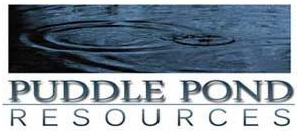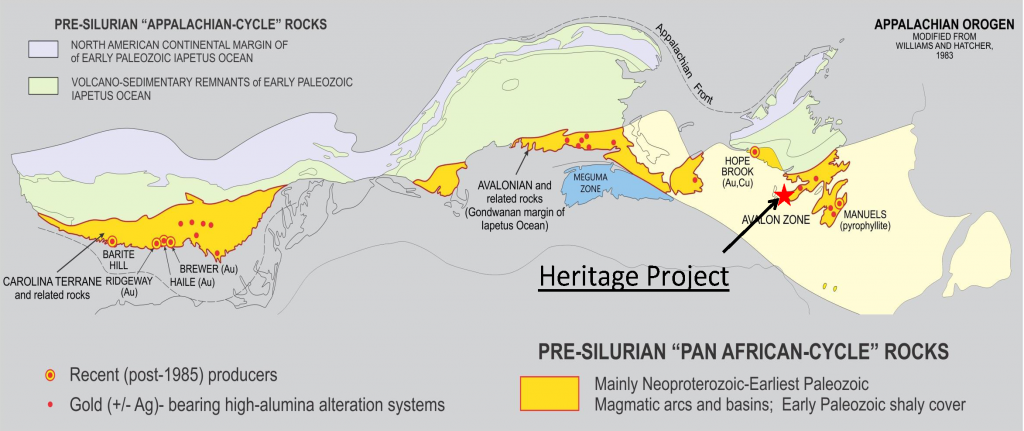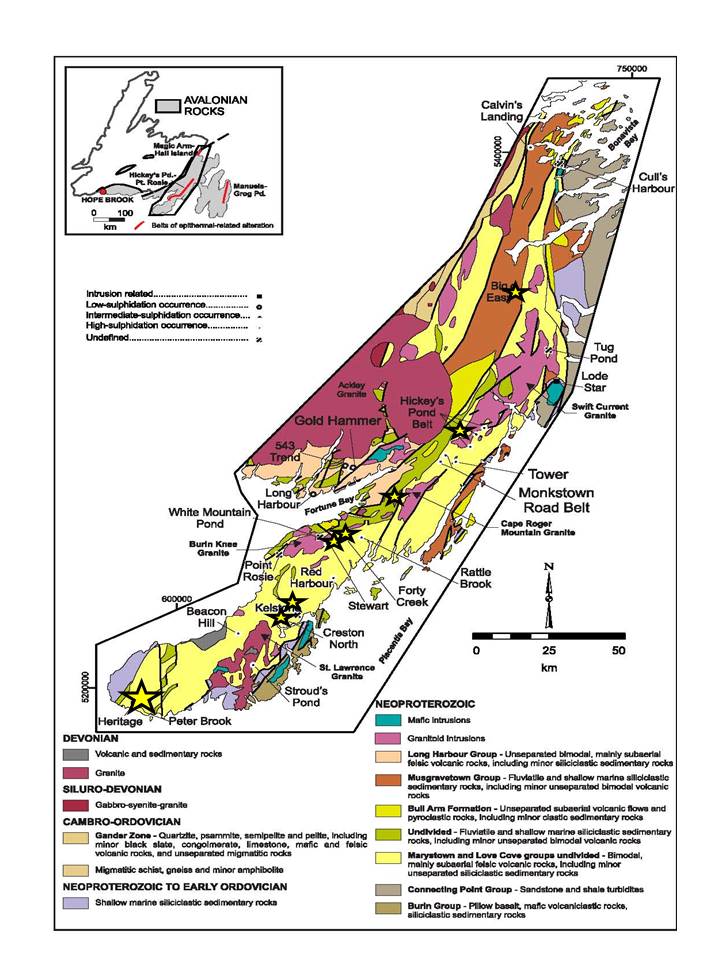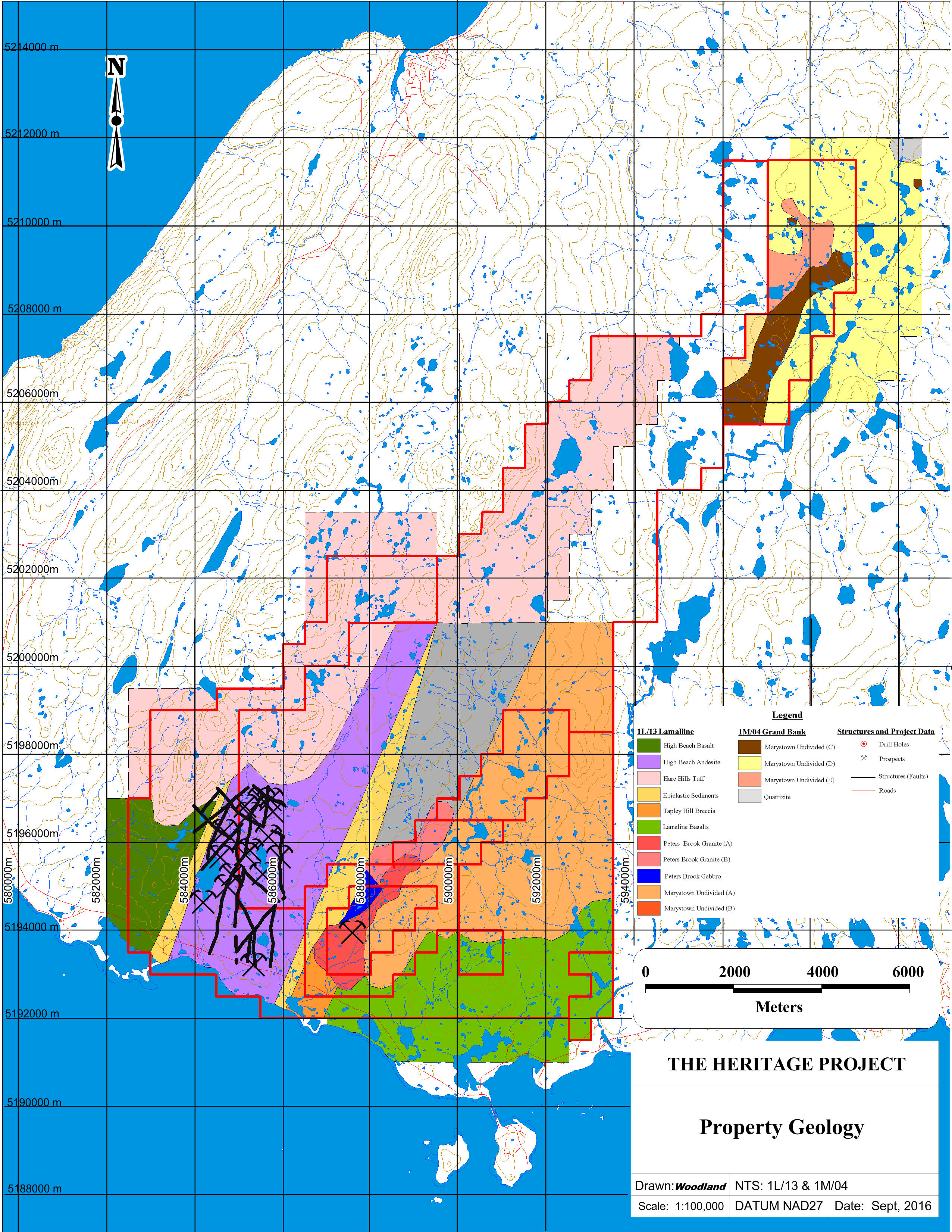The Heritage Gold(Au)-Silver(Ag) Project ~ Geology & Mineralization
The Heritage Project is located in an under-explored section of the Avalon Zone, a belt of rocks extending from southern Newfoundland to South Carolina with a long history of gold and silver production from mines such as the nearby Hope Brook Gold Mine which produced 752,000 ounces of gold and the Haile, Brewer and Ridgeway mines in the Carolina slate belt of South Carolina. The style of gold and silver mineralization occurring on the Heritage Project is classified as low sulphidation, epithermal (hot springs mineralizing environment) gold and silver. This type of deposit occurs worldwide and is a major source of gold and silver. High grade, up to bonanza grades, mineralization is typical of these deposits and one of the premier epithermal gold deposits in the world is the Hishakari Mine located on the island of Kyushu in southern Japan. The deposits at this mine contain over 11 million ounces of gold of which approximately 6.5 million ounces have been mined.
The Avalon Zone of Newfoundland hosts well-preserved examples of high- and low-sulphidation epithermal systems that are amongst some of the oldest known in the world. These Neoproterozoic (500 to 1000 million years old) epithermal systems occur throughout the Avalon Zone and related terrains, from the Carolina Slate Belt in the south to the Avalon Peninsula of Newfoundland in the north.
The most extensive and numerous examples of epithermal alteration systems in Newfoundland are located within the western Avalon Zone, namely the Burin Peninsula region, and the exploration potential of many of these examples remains largely untested in the subsurface. Prospects containing significant gold mineralization (variably associated with silver, copper, arsenic, antimony and zinc) long recognized on the Burin Peninsula are marked by the stars on the geology map of the Burin Peninsula displayed below (Fig 2). The Heritage Project the newest and most significant discovery on the Burin Peninsula is marked by the star at the south end of the peninsula; the Heritage Project is distinguished from other known gold prospects by its high concentrations of silver mineralization.
Figure 2.
Avalon terrane of the Burin peninsula, Newfoundland (O’Brien et al., 1999), showing the 595-575 Ma Marystown Group rocks (yellow) that comprise a volcano-plutonic arc. Arenaceous sedimentary rocks (brown), with bimodal volcanic products, of the Musgrave (in the north) and Long Harbor (to the west) groups constitute an extensional sequence (O’Brien and King, 2002). Hypogene advanced argillic alteration as well as highsulfidation prospects occur in the Marystown Group arc rocks, whereas low-sulfidation vein prospects (e.g., Big Easy, noted as Henry’s Pond in the north, and Heritage in the south) are confined to sedimentary rocks on the west margin of the arc.
The Heritage project is located near Point May in the southern-most portion of the Burin peninsula, hosted by units of the Marystown Group, and overlain by Cambrian sedimentary rocks, all of which have been tilted to the NW, ~20 to 45o (Fig. 3; O’Brien et al., 1977). The Hare Hills Tuff, a sequence of felsic volcanic rocks, is present NW of the main prospect, whereas the underlying High Beach Basalt sequence hosts the epithermal veins and alteration. This unit is composed of lava flow and tuff members as well as sandstones and conglomerates (Fig. 3). Woodland (2015 presentation) notes that this basalt sequence has two members consisting of an andesite porphyry flow and a poorly sorted lithic tuff that hosts most of the alteration. The compositional variation of the High Beach mafic sequence may be consistent with a single sequence of volcanic events (G. Sparkes, pers. commun., 2016). Woodland (2015) notes that the mafic sequence has been affected by a regional low-grade green schist metamorphism, common in the Burin peninsula, which acted as an overprint of hydrothermal alteration at the Heritage property, including a broad propylitic halo.
The epithermal alteration and mineralization were identified by prospectors in 2011 by tracing altered and quartz-veined boulders to areas of bedrock that contain the gold and silver. The High Beach Andesite (outlined in purple in Fig 3) is the exclusive host of the Point May Epithermal System (PMES), consisting of a thick succession of intermediate crystal tuffs, crystal lapilli tuffs, tuff breccias, and coarse pyroclastics. These are broadly indicative of an arc-type volcanic environment during a protracted period fo active magmatism.
The PMES is a low-sulphidation epithermal system, as evidenced by vein hosted textures such as banded veins and bladed silica, in addition to diagnostic sericite-chlorite-adularia alteration. Alteration, as mapped on surface, is characterized by an extensive outer silica – phengite (low temperature clay) zone, which surrounds an inner alteration zone consisting of chalcedony – adularia – illite.
Mineralized veins are easily identifiable by the presence of ginguro style mineralization (GSM), as characterized by black ‘sooty’ stringers and fragments with a fairly simple polymetallic mineral assemblage: native silver and acanthite with lesser amounts of naumannite, electrum, galena, clausthalite, chalcopyrite, and sphalerite.
Since the discovery of the initial prospect exploration work completed by Puddle Pond Resources has to date identified a total of 18 prospects or mineralized zones, two of which were recently discovered in 2016, (the mineralized prospects/zones are denoted by the ‘X’s’ on Fig 3)





